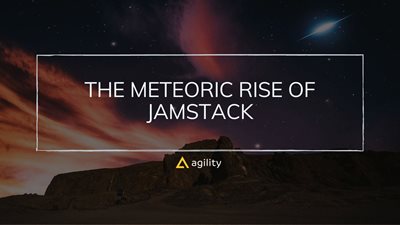The Meteoric Rise of Jamstack
What Is It About Jamstack That Makes It Popular?


Web stacks are technical tools developers use to create a web application. Usually, a tech stack consists of four things: an operating system, a web server, database software, and a programming language for both the frontend and backend.
Choosing the stack for your development is one of the first decisions you have to make, and the right choice can save you and your team headaches and countless hours of development.
Here's where the Jamstack approach can help developers. Jamstack represents a new way of developing software based on build-time and client-side rendering that doesn't depend on web servers for outputting websites and apps.
Jamstack solves many of the problems other tech stacks face and enables quicker development, but before we talk about why and how Jamstack has become one of the hottest stocks in 2020 and beyond, let's take a look at the world before Jamstack.
The World Before Jamstack
Stacking technologies isn't new. Still, in software development, stacking has become necessary to shorten times and standardize development because when you mix the right set of technologies, you get the best website possible.
These are some of the most popular tech stacks around.
LAMP
LAMP is one of the oldest tech stacks out there. LAMP stands for Linux, the operating system; Apache, the web server; MySQL, the database; and a PHP scripting layer.
LAMP is the industry standard for Linux-based servers and gives developers the tools, libraries, and databases to build and run a dynamic HTML website. LAMP has become one of the most popular stacks because it's often sufficient to host different website frameworks like WordPress.
LAMP is suitable for developers who need an out-of-the-box solution that provides a reliable starting point.
MEAN
The MEAN stack is a free, Javascript-based open-source set of tools created in 2013. MEAN stands for MongoDB, the database; Express.js, the web application framework; AngularJS, the frontend framework; and Node.js, the runtime environment.
MEAN supports JavaScript programs and works for server-side and client-side execution environments. The good thing about MEAN is that you can use a single language throughout your stack, thus allowing you to reuse code across your app. Similarly, the technologies are free and open-source with a vibrant developer community.
MEAN is suitable for cloud-hosted applications that can be deployed easily on their servers.
.NET
Created by Microsoft during the early 2000s, .NET enables developers to develop mobile and web applications. .NET is usually hosted in Microsoft Azure, an SQL server, and ASP.NET as the UI layer.
.NET represents a robust tech stack sponsored by Windows and lets developers create windows-based applications proven to run and work correctly in the operating system.
.NET is suitable for Windows-based enterprise development and developers who are used to object-oriented programming.
Read more: Jamstack vs .NET: What The Difference?
What Is It About Jamstack That Makes It Popular?

Jamstack has seen meteoric growth in the past five years, going from a relatively small, obscure tech stack to one of the fastest-growing architectures. In a nutshell, the catalyst that has led to Jamstack's mass adoption is the changing web development trends. These include transitioning from monolithic web applications to apps created using a decoupled architecture that relies on APIs microservices.
With Jamstack, complex monolithic apps can now be broken down into small, independent components that can be easily managed and understood. The introduction of serverless architecture has also created a need for Jamstack, as the stack works perfectly for building lightweight, blazing-fast apps that can be scaled independently.
Why Has Jamstack Exploded So Much?
There are several reasons why Jamstack has grown so much over the past few years, but it's possible to guess why if we take a look at five major trends in the software ecosystem.
- The growth of JavaScript. JavaScript has become a powerful tool at a higher level of abstraction because it enables developers to build faster and more interactive apps, all without forgetting to deliver an improved user experience.
- The proliferation of APIs. On the API side, the myriad of APIs in the market and the simplicity behind building them have made it easier for developers to integrate microservices in the backend and APIs in the front end to aid with content delivery and authoring.
- The sheer number of developers in the world. The growing number of developers and fewer barriers to becoming one has transformed the software industry. New developers bring with them new tools and tricks as well as modern education and different paradigms, which contributes to the adoption of Jamstack.
- The increasing importance of Git. With more developers than ever, communicating and collaborating have become a must, which is why Git has become central to building workflows emphasizing collaboration and version control.
- Cloud infrastructure advancements. Last, with the cloud infrastructure advancements and the reduced computing costs, it has become simpler to implement serverless architectures, giving developers more tools to focus on frontend development to build efficient apps quickly.
The primary catalyst of Jamstack has been that it's now possible to build software without reinventing the wheel for everyday tasks like authentication and data storage, which are now two functions you can externalize to APIs.
In 2020, the trends were directed towards omnichannel delivery, powerful mobile tech, and fast, modern websites and SPAs created using static site generators and distributed using a CDN.
Jamstack and Headless CMS: The Perfect Match
The proliferation of headless CMSs like Agility CMS, Contentful, and Prismic, to name a few, have also made it possible for developers to integrate a CMS into the stack to speed the development process.
In Jamstack-ready CMSs, the DevOps flow includes a build server that combines all the code and content at build time rather than runtime. A Jamstack CMS can create static websites and distribute them to different channels and environments. By building servers, developers prevent security risks and enhance control over the process.
Similarly, thanks to Jamstack, creating and maintaining the website and content infrastructure is more accessible as it doesn't require multiple servers. By a Jamstack-ready headless CMS, packages, libraries, and modules are all in the same place and can be accessed from a single site. Also, Jamstack provides developers with increased security by reducing the entry points available on traditional servers and legacy CMS.
These are some features that a CMS needs to have to help you make the most of the Jamstack architecture:
- Rest APIs or sync SDKs that enhance content delivery,
- The possibility of coding things your way,
- The possibility of integrating with an SSG,
- A hosted and abstracted database.
Jamstack-ready CMS can make the lives of developers easier. They introduce a new layer of security to the development process, enabling developers to roll-back changes with a click of a button, which is a relief in case something goes wrong or is accidentally published. Also, due to its absence of a backend, there's no database for the development team to manage, which means more coding and less time managing.

About the Author
Joel is CTO at Agility. His first job, though, is as a father to 2 amazing humans.
Joining Agility in 2005, he has over 20 years of experience in software development and product management. He embraced cloud technology as a groundbreaking concept over a decade ago, and he continues to help customers adopt new technology with hybrid frameworks and the Jamstack. He holds a degree from The University of Guelph in English and Computer Science. He's led Agility CMS to many awards and accolades during his tenure such as being named the Best Cloud CMS by CMS Critic, as a leader on G2.com for Headless CMS, and a leader in Customer Experience on Gartner Peer Insights.
As CTO, Joel oversees the Product team, as well as working closely with the Growth and Customer Success teams. When he's not kicking butt with Agility, Joel coaches high-school football and directs musical theatre. Learn more about Joel HERE.



